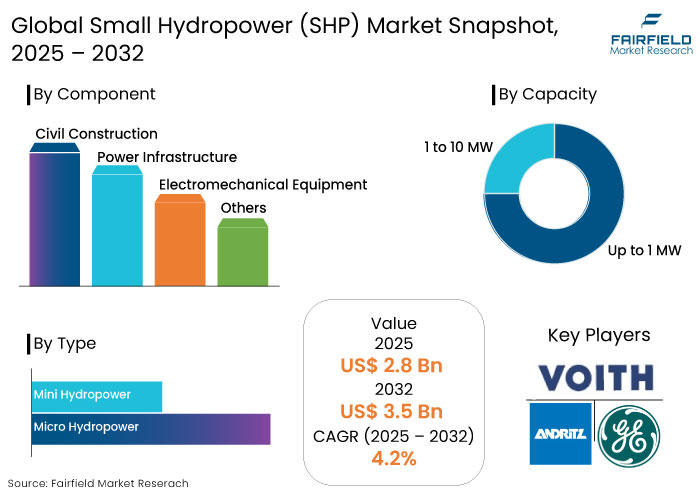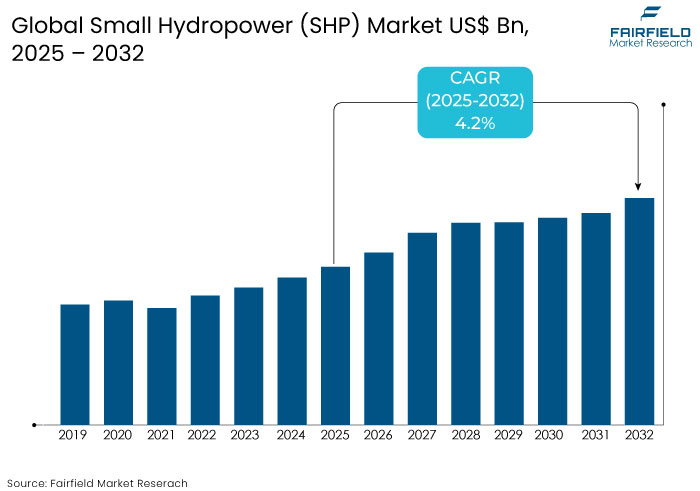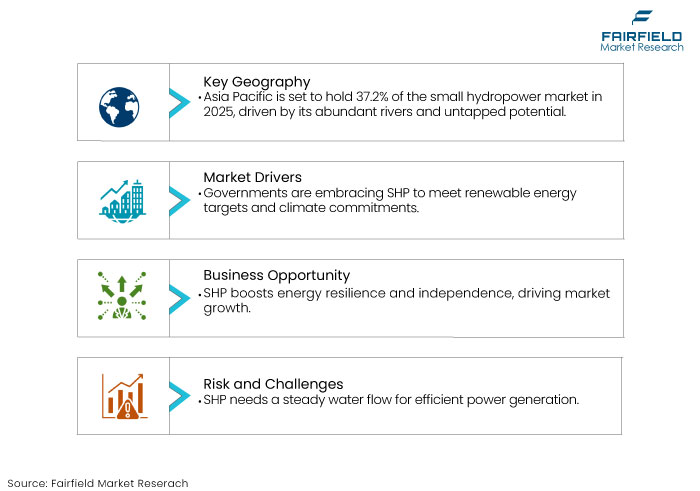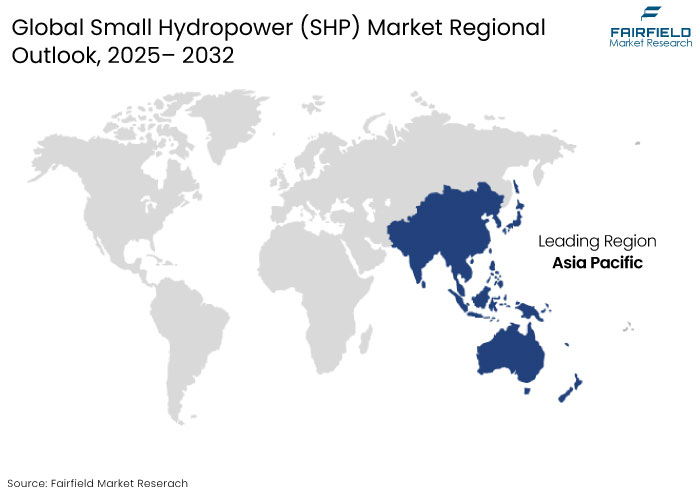Global Small Hydropower (SHP) Market Forecast
- The small hydropower (SHP) market is projected to be valued at US$ 3.5 Bn by 2032 from US$ 2.8 Bn predicted in 2025.
- The small hydropower (SHP) market is estimated to witness a CAGR of 4.2% between 2025 and 2032.

Small Hydropower (SHP) Market Insights
- Development of decentralized energy generation in rural and off-grid areas is likely to spur growth.
- International organizations, like the International Renewable Energy Agency (IRENA) and World Bank, are financing SHP projects in developing nations.
- Projects in Sub-Saharan Africa and South Asia have led to electrification of rural communities, boosting economic development.
- SHP systems are preferred for their low ecological impact compared to large hydropower dams.
- Global goals for net-zero emissions by 2050 are accelerating SHP adoption as part of the renewable energy mix.
- Innovations like smart grids, automated control systems, and modular turbines are enhancing the efficiency and scalability of SHP systems.
- Emerging technologies like floating small hydropower plants are estimated to surge potential installation sites.
- SHP systems have lower operational and maintenance costs compared to other renewable sources like solar and wind.
Key Growth Determinants
- Favorable Government Policies and Incentives
Governments worldwide are setting ambitious renewable energy targets as part of their commitments to climate action. As a renewable energy solution, SHP plays a significant role in helping nations meet their energy goals.
Under the Paris Agreement, 190 countries have pledged to decrease carbon emissions and transition to cleaner energy sources. The European Union (EU) is targeting 40% of total energy consumption from renewables by 2030, with SHP being a prominent contributor, especially in countries like Austria, France, and Germany. These favorable policies are set to drive the small hydropower (SHP) market.
- Climate Change and Sustainability Goals
Countries across the globe have pledged to reach carbon neutrality by mid-century. SHP systems are key to reducing GHG emissions in the power sector as they provide a renewable and non-fossil fuel-based energy source. China aims to achieve carbon neutrality by 2060, and the European Union set a target to reduce greenhouse gas (GHG) emissions by 55% by 2030.
Countries in the small hydropower (SHP) market are shifting to renewable sources with hydropower playing a critical role. SHP assists in diversifying the energy mix, thereby making it sustainable and resilient against climate change impacts. The International Renewable Energy Agency (IRENA) reports that renewables accounted for 82% of all new power capacity globally in 2020, with hydropower representing a significant portion of that.

Key Growth Barriers
- Geographic and Site Limitations
Small hydropower systems require a reliable and consistent water source with adequate flow. These systems rely on the kinetic energy of water to generate electricity, meaning that without sufficient water flow, power generation becomes impossible or inefficient.
Several regions, especially those in arid or semi-arid climates, face seasonal variations in water availability. During dry periods, rivers in these regions may have lower water flow, making it challenging to maintain a consistent output and hampering the small hydropower (SHP) market.
Small Hydropower (SHP) Market Trends and Opportunities
- Rising Demand for Decentralized Energy
Decentralized energy systems like small hydropower plants provide a more resilient energy infrastructure, especially for remote and off-grid areas. Localized energy generation decreases reliance on external energy sources and central grids, contributing to energy independence for individuals as well as nations. It is projected that the small hydropower (SHP) market will rise owing to the aforementioned factor.
Small hydropower offers a reliable and renewable source of energy, enhancing energy security and mitigating risks associated with grid failures, energy price fluctuations, and geopolitical tensions. In Nepal, where rugged terrain limits the reach of central electricity grids, small hydropower systems are widely deployed to meet the energy needs of rural populations.
- Integration with Hybrid Systems
Hybrid systems, especially those combining small hydropower with solar and wind, provide a reliable and steady power supply by mitigating the variability that often accompanies renewable energy sources. Hybrid systems can also be integrated into local grids or microgrids, improving grid stability and energy security.
According to the International Renewable Energy Agency (IRENA), hybrid renewable energy systems are predicted to play a crucial role, especially for rural electrification. Technological advances in hybrid power systems are facilitating the small hydropower (SHP) market. New control systems, battery storage technologies, and smart grid integration enable better management of the energy generated from multiple sources.

Segments Covered in the Report
- Civil Construction is Key for Developing the Infrastructure of SHP Plants
In terms of component, the civil construction segment is predicted to hold a small hydropower (SHP) market share of 36.2% in 2025. Small hydropower plants require significant civil construction efforts to build the necessary infrastructure. As a result, civil construction plays a critical role in the feasibility and operational success of these projects.
According to IRENA, civil works can account for 40% to 50% of the total project cost, making this component the largest cost driver in many SHP installations. SHP projects require highly customized civil works to suit the local terrain, water flow, and environmental condition. The diversity of potential locations requires site-specific designs and engineering solutions.
- Focus on Decentralized Solutions to Augment Micro Hydropower
Based on type, the micro hydropower segment is anticipated to hold a small hydropower (SHP) market share of 60% in 2025. Micro hydropower systems are highly suitable for off-grid locations and rural areas that may not have access to the central grid. Rising demand for rural electrification and energy access in remote regions are making micro hydropower an attractive solution.
According to the International Energy Agency (IEA), around 800 million people worldwide still lack access to electricity, and micro hydropower is seen as a viable solution to provide power to such underserved populations. Micro hydropower offers a decentralized model of energy production. This aligns with the global shift toward decentralized energy generation, ensuring greater energy security and reliability.
Regional Analysis
- Asia Pacific to See Rising Energy Production in China and India
Asia Pacific is likely to hold a small hydropower (SHP) market share of 37.2% in 2025. The region is home to few of the largest hydropower markets globally, with a vast untapped potential for small hydropower systems. Asia Pacific’s several rivers and watercourses make it an ideal location for small hydropower projects.
Countries like China, India, Vietnam, and Indonesia have abundant hydropower resources that can be harnessed for small-scale energy production. According to the IEA, Asia Pacific accounts for 70% of the global hydropower capacity, with China and India leading the way in terms of total installed capacity.

- Europe’s Strong Commitments for Renewable Energy to Bolster Growth
Europe is projected to hold a small hydropower (SHP) market share of 23.8% in 2025. The region has been a leader in the adoption of renewable energy, including hydropower. It is home to more than 25,000 small hydropower plants, contributing substantially to the region's renewable energy mix.
As part of the European Green Deal, the European Union (EU) has set ambitious targets to achieve climate neutrality by 2050. A significant portion of this goal relies on renewable energy sources like wind, solar, and hydropower. According to reports, hydropower accounts for 13% to 14% of the EU’s total electricity consumption.
Fairfield’s Competitive Landscape Analysis
Companies in the small hydropower (SHP) market are investing in research and development to design innovative components that enhance the efficiency of small hydropower systems. Low-head and micro-hydropower turbines, which are ideal for areas with limited water flow, are particularly gaining traction.
Businesses are incorporating IoT, AI, and ML technologies in hydropower systems to improve monitoring, automation, and predictive maintenance. This not only enhances the performance of the systems but also decreases operational costs and increases reliability.
Key Market Companies
- Andritz Hydro
- GE Renewable Energy
- Voith Hydro
- Siemens AG
- Alstom
- Statkraft
- Hydro-Québec
- Sener Group
- CNR (China National Renewable Energy)
- EDP Renewables
- Tractebel
- Bluegreen Energy
- Hydro Tasmania
- Energias de Portugal (EDP)
- GEV (Green Energy Ventures)
Recent Industry Developments
- In January 2025, Gerdau SA, a steel producer in Brazil, agreed to acquire 58 MW of small hydropower plants from local renewable energy company, Atiaia Energia.
- In January 2025, the regional administration announced that a small hydropower plant named Zarchob-2A, has been commissioned at the Tupolang Reservoir cascade in the Surkhandarya region.
- In September 2024, chartered engineer Jacob Jose handed a proposal to the chairman of State Electricity Regulatory Commission, T.K. Jose, to increase the efficiency of 126 small hydropower projects in Kerala to generate 777 MW of electricity, thereby alleviating the state’s energy crisis.
- In July 2024, Himachal Pradesh held a special consultation meeting to discuss the Draft national Small Hydropower Policy (NSHP) 2024, organized by the Ministry of New and Renewable Energy (MNRE) to bolster the small hydropower sector.
Global Small Hydropower (SHP) Market is Segmented as-
By Component
- Civil Construction
- Power Infrastructure
- Electromechanical Equipment
- Others
By Capacity
- Up to 1 MW
- 1 to 10 MW
By Type
- Micro Hydropower
- Mini Hydropower
By Region
- North America
- Europe
- Asia Pacific
- Latin America
- Middle East and Africa
1. Executive Summary
1.1. Global Small Hydropower (SHP) Market Snapshot
1.2. Future Projections
1.3. Key Market Trends
1.4. Regional Snapshot, by Value, 2025
1.5. Analyst Recommendations
2. Market Overview
2.1. Market Definitions and Segmentations
2.2. Market Dynamics
2.2.1. Drivers
2.2.2. Restraints
2.2.3. Market Opportunities
2.3. Value Chain Analysis
2.4. Porter’s Five Forces Analysis
2.5. COVID-19 Impact Analysis
2.5.1. Supply
2.5.2. Demand
2.6. Impact of Ukraine-Russia Conflict
2.7. Economic Overview
2.7.1. World Economic Projections
2.8. PESTLE Analysis
3. Global Small Hydropower (SHP) Market Outlook, 2019 - 2032
3.1. Global Small Hydropower (SHP) Market Outlook, by Component Insight, Value (US$ Bn), 2019 - 2032
3.1.1. Key Highlights
3.1.1.1. Civil Construction
3.1.1.2. Power Infrastructure
3.1.1.3. Electromechanical Equipment
3.1.1.4. Others
3.2. Global Small Hydropower (SHP) Market Outlook, By Capacity Insights, Value (US$ Bn), 2019 - 2032
3.2.1. Key Highlights
3.2.1.1. Up to 1 MW
3.2.1.2. 1 to 10 MW
3.3. Global Small Hydropower (SHP) Market Outlook, by Type Insights, Value (US$ Bn), 2019 - 2032
3.3.1. Key Highlights
3.3.1.1. Micro Hydropower
3.3.1.2. Mini Hydropower
3.4. Global Small Hydropower (SHP) Market Outlook, by Region, Value (US$ Bn), 2019 - 2032
3.4.1. Key Highlights
3.4.1.1. North America
3.4.1.2. Europe
3.4.1.3. Asia Pacific
3.4.1.4. Latin America
3.4.1.5. Middle East & Africa
4. North America Small Hydropower (SHP) Market Outlook, 2019 - 2032
4.1. North America Small Hydropower (SHP) Market Outlook, by Component Insight, Value (US$ Bn), 2019 - 2032
4.1.1. Key Highlights
4.1.1.1. Civil Construction
4.1.1.2. Power Infrastructure
4.1.1.3. Electromechanical Equipment
4.1.1.4. Others
4.2. North America Small Hydropower (SHP) Market Outlook, By Capacity Insights, Value (US$ Bn), 2019 - 2032
4.2.1. Key Highlights
4.2.1.1. Up to 1 MW
4.2.1.2. 1-10 MW
4.3. North America Small Hydropower (SHP) Market Outlook, by Type Insights, Value (US$ Bn), 2019 - 2032
4.3.1. Key Highlights
4.3.1.1. Micro Hydropower
4.3.1.2. Mini Hydropower
4.3.2. BPS Analysis/Market Attractiveness Analysis
4.4. North America Small Hydropower (SHP) Market Outlook, by Country, Value (US$ Bn), 2019 - 2032
4.4.1. Key Highlights
4.4.1.1. U.S. Small Hydropower (SHP) Market by Component Insight, Value (US$ Bn), 2019 - 2032
4.4.1.2. U.S. Small Hydropower (SHP) Market By Capacity Insights, Value (US$ Bn), 2019 - 2032
4.4.1.3. U.S. Small Hydropower (SHP) Market by Type Insights, Value (US$ Bn), 2019 - 2032
4.4.1.4. Canada Small Hydropower (SHP) Market by Component Insight, Value (US$ Bn), 2019 - 2032
4.4.1.5. Canada Small Hydropower (SHP) Market By Capacity Insights, Value (US$ Bn), 2019 - 2032
4.4.1.6. Canada Small Hydropower (SHP) Market by Type Insights, Value (US$ Bn), 2019 - 2032
4.4.2. BPS Analysis/Market Attractiveness Analysis
5. Europe Small Hydropower (SHP) Market Outlook, 2019 - 2032
5.1. Europe Small Hydropower (SHP) Market Outlook, by Component Insight, Value (US$ Bn), 2019 - 2032
5.1.1. Key Highlights
5.1.1.1. Civil Construction
5.1.1.2. Power Infrastructure
5.1.1.3. Electromechanical Equipment
5.1.1.4. Others
5.2. Europe Small Hydropower (SHP) Market Outlook, By Capacity Insights, Value (US$ Bn), 2019 - 2032
5.2.1. Key Highlights
5.2.1.1. Up to 1 MW
5.2.1.2. 1-10 MW
5.3. Europe Small Hydropower (SHP) Market Outlook, by Type Insights, Value (US$ Bn), 2019 - 2032
5.3.1. Key Highlights
5.3.1.1. Micro Hydropower
5.3.1.2. Mini Hydropower
5.3.2. BPS Analysis/Market Attractiveness Analysis
5.4. Europe Small Hydropower (SHP) Market Outlook, by Country, Value (US$ Bn), 2019 - 2032
5.4.1. Key Highlights
5.4.1.1. Germany Small Hydropower (SHP) Market by Component Insight, Value (US$ Bn), 2019 - 2032
5.4.1.2. Germany Small Hydropower (SHP) Market By Capacity Insights, Value (US$ Bn), 2019 - 2032
5.4.1.3. Germany Small Hydropower (SHP) Market by Type Insights, Value (US$ Bn), 2019 - 2032
5.4.1.4. U.K. Small Hydropower (SHP) Market by Component Insight, Value (US$ Bn), 2019 - 2032
5.4.1.5. U.K. Small Hydropower (SHP) Market By Capacity Insights, Value (US$ Bn), 2019 - 2032
5.4.1.6. U.K. Small Hydropower (SHP) Market by Type Insights, Value (US$ Bn), 2019 - 2032
5.4.1.7. France Small Hydropower (SHP) Market by Component Insight, Value (US$ Bn), 2019 - 2032
5.4.1.8. France Small Hydropower (SHP) Market By Capacity Insights, Value (US$ Bn), 2019 - 2032
5.4.1.9. France Small Hydropower (SHP) Market by Type Insights, Value (US$ Bn), 2019 - 2032
5.4.1.10. Italy Small Hydropower (SHP) Market by Component Insight, Value (US$ Bn), 2019 - 2032
5.4.1.11. Italy Small Hydropower (SHP) Market By Capacity Insights, Value (US$ Bn), 2019 - 2032
5.4.1.12. Italy Small Hydropower (SHP) Market by Type Insights, Value (US$ Bn), 2019 - 2032
5.4.1.13. Turkey Small Hydropower (SHP) Market by Component Insight, Value (US$ Bn), 2019 - 2032
5.4.1.14. Turkey Small Hydropower (SHP) Market By Capacity Insights, Value (US$ Bn), 2019 - 2032
5.4.1.15. Turkey Small Hydropower (SHP) Market by Type Insights, Value (US$ Bn), 2019 - 2032
5.4.1.16. Russia Small Hydropower (SHP) Market by Component Insight, Value (US$ Bn), 2019 - 2032
5.4.1.17. Russia Small Hydropower (SHP) Market By Capacity Insights, Value (US$ Bn), 2019 - 2032
5.4.1.18. Russia Small Hydropower (SHP) Market by Type Insights, Value (US$ Bn), 2019 - 2032
5.4.1.19. Rest of Europe Small Hydropower (SHP) Market by Component Insight, Value (US$ Bn), 2019 - 2032
5.4.1.20. Rest of Europe Small Hydropower (SHP) Market By Capacity Insights, Value (US$ Bn), 2019 - 2032
5.4.1.21. Rest of Europe Small Hydropower (SHP) Market by Type Insights, Value (US$ Bn), 2019 - 2032
5.4.2. BPS Analysis/Market Attractiveness Analysis
6. Asia Pacific Small Hydropower (SHP) Market Outlook, 2019 - 2032
6.1. Asia Pacific Small Hydropower (SHP) Market Outlook, by Component Insight, Value (US$ Bn), 2019 - 2032
6.1.1. Key Highlights
6.1.1.1. Civil Construction
6.1.1.2. Power Infrastructure
6.1.1.3. Electromechanical Equipment
6.1.1.4. Others
6.2. Asia Pacific Small Hydropower (SHP) Market Outlook, By Capacity Insights, Value (US$ Bn), 2019 - 2032
6.2.1. Key Highlights
6.2.1.1. Up to 1 MW
6.2.1.2. 1-10 MW
6.3. Asia Pacific Small Hydropower (SHP) Market Outlook, by Type Insights, Value (US$ Bn), 2019 - 2032
6.3.1. Key Highlights
6.3.1.1. Micro Hydropower
6.3.1.2. Mini Hydropower
6.3.2. BPS Analysis/Market Attractiveness Analysis
6.4. Asia Pacific Small Hydropower (SHP) Market Outlook, by Country, Value (US$ Bn), 2019 - 2032
6.4.1. Key Highlights
6.4.1.1. China Small Hydropower (SHP) Market by Component Insight, Value (US$ Bn), 2019 - 2032
6.4.1.2. China Small Hydropower (SHP) Market By Capacity Insights, Value (US$ Bn), 2019 - 2032
6.4.1.3. China Small Hydropower (SHP) Market by Type Insights, Value (US$ Bn), 2019 - 2032
6.4.1.4. Japan Small Hydropower (SHP) Market by Component Insight, Value (US$ Bn), 2019 - 2032
6.4.1.5. Japan Small Hydropower (SHP) Market By Capacity Insights, Value (US$ Bn), 2019 - 2032
6.4.1.6. Japan Small Hydropower (SHP) Market by Type Insights, Value (US$ Bn), 2019 - 2032
6.4.1.7. South Korea Small Hydropower (SHP) Market by Component Insight, Value (US$ Bn), 2019 - 2032
6.4.1.8. South Korea Small Hydropower (SHP) Market By Capacity Insights, Value (US$ Bn), 2019 - 2032
6.4.1.9. South Korea Small Hydropower (SHP) Market by Type Insights, Value (US$ Bn), 2019 - 2032
6.4.1.10. India Small Hydropower (SHP) Market by Component Insight, Value (US$ Bn), 2019 - 2032
6.4.1.11. India Small Hydropower (SHP) Market By Capacity Insights, Value (US$ Bn), 2019 - 2032
6.4.1.12. India Small Hydropower (SHP) Market by Type Insights, Value (US$ Bn), 2019 - 2032
6.4.1.13. Southeast Asia Small Hydropower (SHP) Market by Component Insight, Value (US$ Bn), 2019 - 2032
6.4.1.14. Southeast Asia Small Hydropower (SHP) Market By Capacity Insights, Value (US$ Bn), 2019 - 2032
6.4.1.15. Southeast Asia Small Hydropower (SHP) Market by Type Insights, Value (US$ Bn), 2019 - 2032
6.4.1.16. Rest of Asia Pacific Small Hydropower (SHP) Market by Component Insight, Value (US$ Bn), 2019 - 2032
6.4.1.17. Rest of Asia Pacific Small Hydropower (SHP) Market By Capacity Insights, Value (US$ Bn), 2019 - 2032
6.4.1.18. Rest of Asia Pacific Small Hydropower (SHP) Market by Type Insights, Value (US$ Bn), 2019 - 2032
6.4.2. BPS Analysis/Market Attractiveness Analysis
7. Latin America Small Hydropower (SHP) Market Outlook, 2019 - 2032
7.1. Latin America Small Hydropower (SHP) Market Outlook, by Component Insight, Value (US$ Bn), 2019 - 2032
7.1.1. Key Highlights
7.1.1.1. Civil Construction
7.1.1.2. Power Infrastructure
7.1.1.3. Electromechanical Equipment
7.1.1.4. Others
7.2. Latin America Small Hydropower (SHP) Market Outlook, By Capacity Insights, Value (US$ Bn), 2019 - 2032
7.2.1. Key Highlights
7.2.1.1. Up to 1 MW
7.2.1.2. 1-10 MW
7.3. Latin America Small Hydropower (SHP) Market Outlook, by Type Insights, Value (US$ Bn), 2019 - 2032
7.3.1. Key Highlights
7.3.1.1. Micro Hydropower
7.3.1.2. Mini Hydropower
7.3.2. BPS Analysis/Market Attractiveness Analysis
7.4. Latin America Small Hydropower (SHP) Market Outlook, by Country, Value (US$ Bn), 2019 - 2032
7.4.1. Key Highlights
7.4.1.1. Brazil Small Hydropower (SHP) Market by Component Insight, Value (US$ Bn), 2019 - 2032
7.4.1.2. Brazil Small Hydropower (SHP) Market By Capacity Insights, Value (US$ Bn), 2019 - 2032
7.4.1.3. Brazil Small Hydropower (SHP) Market by Type Insights, Value (US$ Bn), 2019 - 2032
7.4.1.4. Mexico Small Hydropower (SHP) Market by Component Insight, Value (US$ Bn), 2019 - 2032
7.4.1.5. Mexico Small Hydropower (SHP) Market By Capacity Insights, Value (US$ Bn), 2019 - 2032
7.4.1.6. Mexico Small Hydropower (SHP) Market by Type Insights, Value (US$ Bn), 2019 - 2032
7.4.1.7. Argentina Small Hydropower (SHP) Market by Component Insight, Value (US$ Bn), 2019 - 2032
7.4.1.8. Argentina Small Hydropower (SHP) Market By Capacity Insights, Value (US$ Bn), 2019 - 2032
7.4.1.9. Argentina Small Hydropower (SHP) Market by Type Insights, Value (US$ Bn), 2019 - 2032
7.4.1.10. Rest of Latin America Small Hydropower (SHP) Market by Component Insight, Value (US$ Bn), 2019 - 2032
7.4.1.11. Rest of Latin America Small Hydropower (SHP) Market By Capacity Insights, Value (US$ Bn), 2019 - 2032
7.4.1.12. Rest of Latin America Small Hydropower (SHP) Market by Type Insights, Value (US$ Bn), 2019 - 2032
7.4.2. BPS Analysis/Market Attractiveness Analysis
8. Middle East & Africa Small Hydropower (SHP) Market Outlook, 2019 - 2032
8.1. Middle East & Africa Small Hydropower (SHP) Market Outlook, by Component Insight, Value (US$ Bn), 2019 - 2032
8.1.1. Key Highlights
8.1.1.1. Civil Construction
8.1.1.2. Power Infrastructure
8.1.1.3. Electromechanical Equipment
8.1.1.4. Others
8.2. Middle East & Africa Small Hydropower (SHP) Market Outlook, By Capacity Insights, Value (US$ Bn), 2019 - 2032
8.2.1. Key Highlights
8.2.1.1. Up to 1 MW
8.2.1.2. 1-10 MW
8.3. Middle East & Africa Small Hydropower (SHP) Market Outlook, by Type Insights, Value (US$ Bn), 2019 - 2032
8.3.1. Key Highlights
8.3.1.1. Micro Hydropower
8.3.1.2. Mini Hydropower
8.3.2. BPS Analysis/Market Attractiveness Analysis
8.4. Middle East & Africa Small Hydropower (SHP) Market Outlook, by Country, Value (US$ Bn), 2019 - 2032
8.4.1. Key Highlights
8.4.1.1. GCC Small Hydropower (SHP) Market by Component Insight, Value (US$ Bn), 2019 - 2032
8.4.1.2. GCC Small Hydropower (SHP) Market By Capacity Insights, Value (US$ Bn), 2019 - 2032
8.4.1.3. GCC Small Hydropower (SHP) Market by Type Insights, Value (US$ Bn), 2019 - 2032
8.4.1.4. South Africa Small Hydropower (SHP) Market by Component Insight, Value (US$ Bn), 2019 - 2032
8.4.1.5. South Africa Small Hydropower (SHP) Market By Capacity Insights, Value (US$ Bn), 2019 - 2032
8.4.1.6. South Africa Small Hydropower (SHP) Market by Type Insights, Value (US$ Bn), 2019 - 2032
8.4.1.7. Egypt Small Hydropower (SHP) Market by Component Insight, Value (US$ Bn), 2019 - 2032
8.4.1.8. Egypt Small Hydropower (SHP) Market By Capacity Insights, Value (US$ Bn), 2019 - 2032
8.4.1.9. Egypt Small Hydropower (SHP) Market by Type Insights, Value (US$ Bn), 2019 - 2032
8.4.1.10. Nigeria Small Hydropower (SHP) Market by Component Insight, Value (US$ Bn), 2019 - 2032
8.4.1.11. Nigeria Small Hydropower (SHP) Market By Capacity Insights, Value (US$ Bn), 2019 - 2032
8.4.1.12. Nigeria Small Hydropower (SHP) Market by Type Insights, Value (US$ Bn), 2019 - 2032
8.4.1.13. Rest of Middle East & Africa Small Hydropower (SHP) Market by Component Insight, Value (US$ Bn), 2019 - 2032
8.4.1.14. Rest of Middle East & Africa Small Hydropower (SHP) Market By Capacity Insights, Value (US$ Bn), 2019 - 2032
8.4.1.15. Rest of Middle East & Africa Small Hydropower (SHP) Market by Type Insights, Value (US$ Bn), 2019 - 2032
8.4.2. BPS Analysis/Market Attractiveness Analysis
9. Competitive Landscape
9.1. Company Market Share Analysis, 2025
9.2. Competitive Dashboard
9.3. Company Profiles
9.3.1. Andritz Hydro
9.3.1.1. Company Overview
9.3.1.2. Product Portfolio
9.3.1.3. Financial Overview
9.3.1.4. Business Strategies and Development
9.3.2. GE Renewable Energy
9.3.2.1. Company Overview
9.3.2.2. Product Portfolio
9.3.2.3. Financial Overview
9.3.2.4. Business Strategies and Development
9.3.3. Voith Hydro
9.3.3.1. Company Overview
9.3.3.2. Product Portfolio
9.3.3.3. Financial Overview
9.3.3.4. Business Strategies and Development
9.3.4. Siemens AG
9.3.4.1. Company Overview
9.3.4.2. Product Portfolio
9.3.4.3. Financial Overview
9.3.4.4. Business Strategies and Development
9.3.5. Alstom
9.3.5.1. Company Overview
9.3.5.2. Product Portfolio
9.3.5.3. Financial Overview
9.3.5.4. Business Strategies and Development
9.3.6. Statkraft
9.3.6.1. Company Overview
9.3.6.2. Product Portfolio
9.3.6.3. Financial Overview
9.3.6.4. Business Strategies and Development
9.3.7. Hydro-Québec
9.3.7.1. Company Overview
9.3.7.2. Product Portfolio
9.3.7.3. Financial Overview
9.3.7.4. Business Strategies and Development
9.3.8. Sener Group
9.3.8.1. Company Overview
9.3.8.2. Product Portfolio
9.3.8.3. Financial Overview
9.3.8.4. Business Strategies and Development
9.3.9. CNR (China National Renewable Energy)
9.3.9.1. Company Overview
9.3.9.2. Product Portfolio
9.3.9.3. Financial Overview
9.3.9.4. Business Strategies and Development
9.3.10. EDP Renewables
9.3.10.1. Company Overview
9.3.10.2. Product Portfolio
9.3.10.3. Financial Overview
9.3.10.4. Business Strategies and Development
9.3.11. Tractebel
9.3.11.1. Company Overview
9.3.11.2. Product Portfolio
9.3.11.3. Financial Overview
9.3.11.4. Business Strategies and Development
9.3.12. Bluegreen Energy
9.3.12.1. Company Overview
9.3.12.2. Product Portfolio
9.3.12.3. Financial Overview
9.3.12.4. Business Strategies and Development
9.3.13. Hydro Tasmania
9.3.13.1. Company Overview
9.3.13.2. Product Portfolio
9.3.13.3. Financial Overview
9.3.13.4. Business Strategies and Development
9.3.14. Energias de Portugal (EDP)
9.3.14.1. Company Overview
9.3.14.2. Product Portfolio
9.3.14.3. Financial Overview
9.3.14.4. Business Strategies and Development
9.3.15. GEV (Green Energy Ventures)
9.3.15.1. Company Overview
9.3.15.2. Product Portfolio
9.3.15.3. Financial Overview
9.3.15.4. Business Strategies and Development
10. Appendix
10.1. Research Methodology
10.2. Report Assumptions
10.3. Acronyms and Abbreviations
|
BASE YEAR |
HISTORICAL DATA |
FORECAST PERIOD |
UNITS |
|||
|
2024 |
|
2019 - 2023 |
2025 - 2032 |
Value: US$ Billion |
||
|
REPORT FEATURES |
DETAILS |
|
Component CoverageREPORT |
|
|
Capacity Coverage |
|
|
Type Coverage |
|
|
Geographical Coverage |
|
|
Leading Companies |
|
|
Report Highlights |
Key Market Indicators, Macro-micro economic impact analysis, Technological Roadmap, Key Trends, Driver, Restraints, and Future Opportunities & Revenue Pockets, Porter’s 5 Forces Analysis, Historical Trend (2019-2023), Market Estimates and Forecast, Market Dynamics, Industry Trends, Competition Landscape, Category, Region, Country-wise Trends & Analysis, COVID-19 Impact Analysis (Demand and Supply Chain) |
